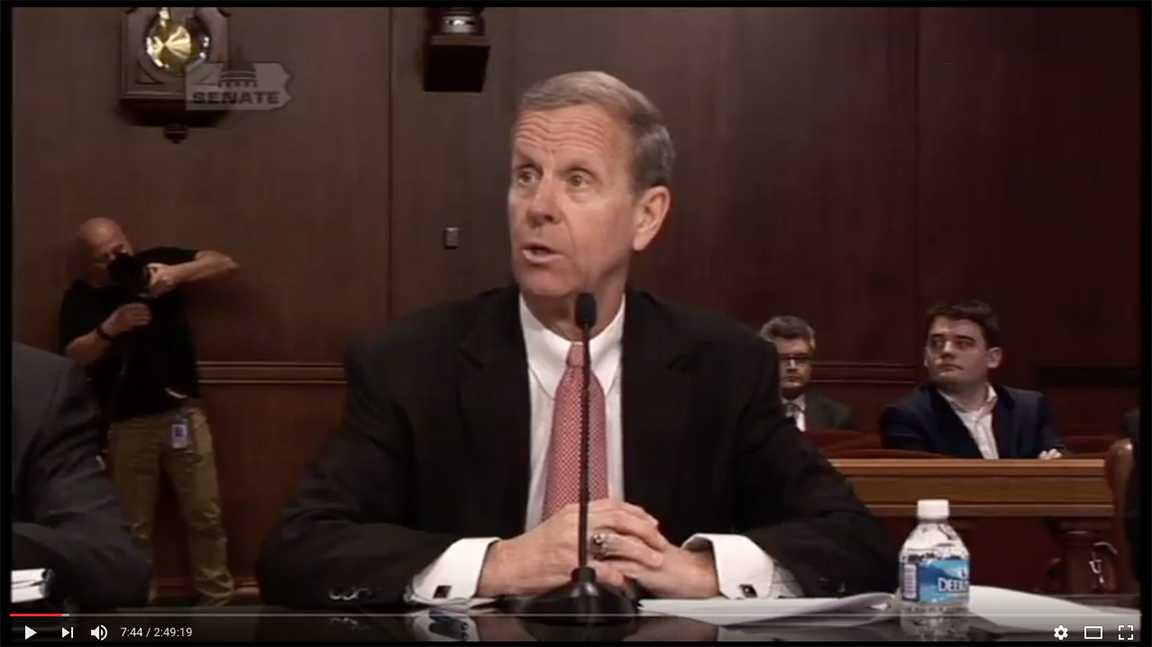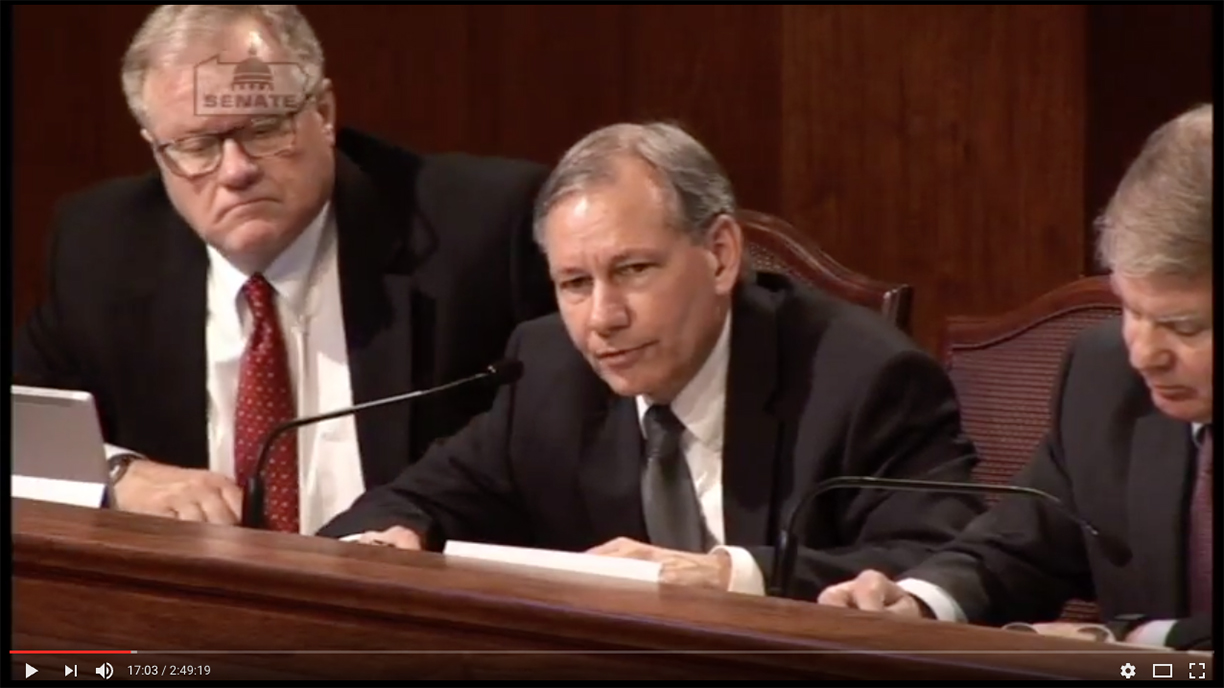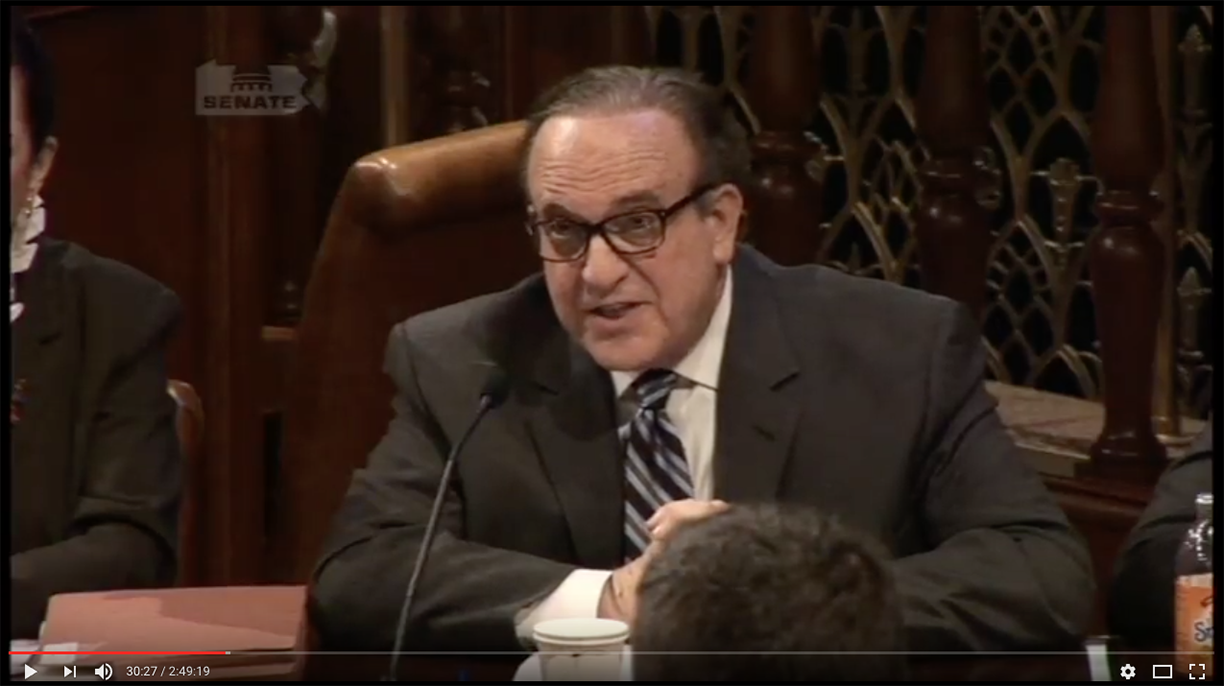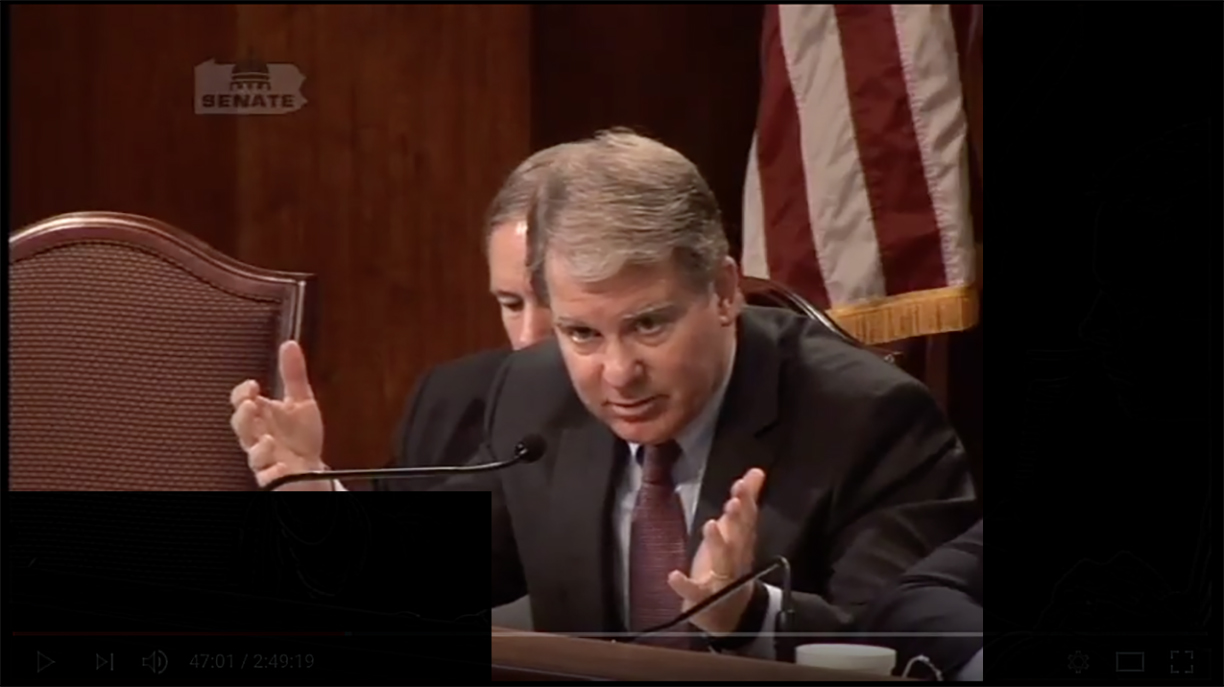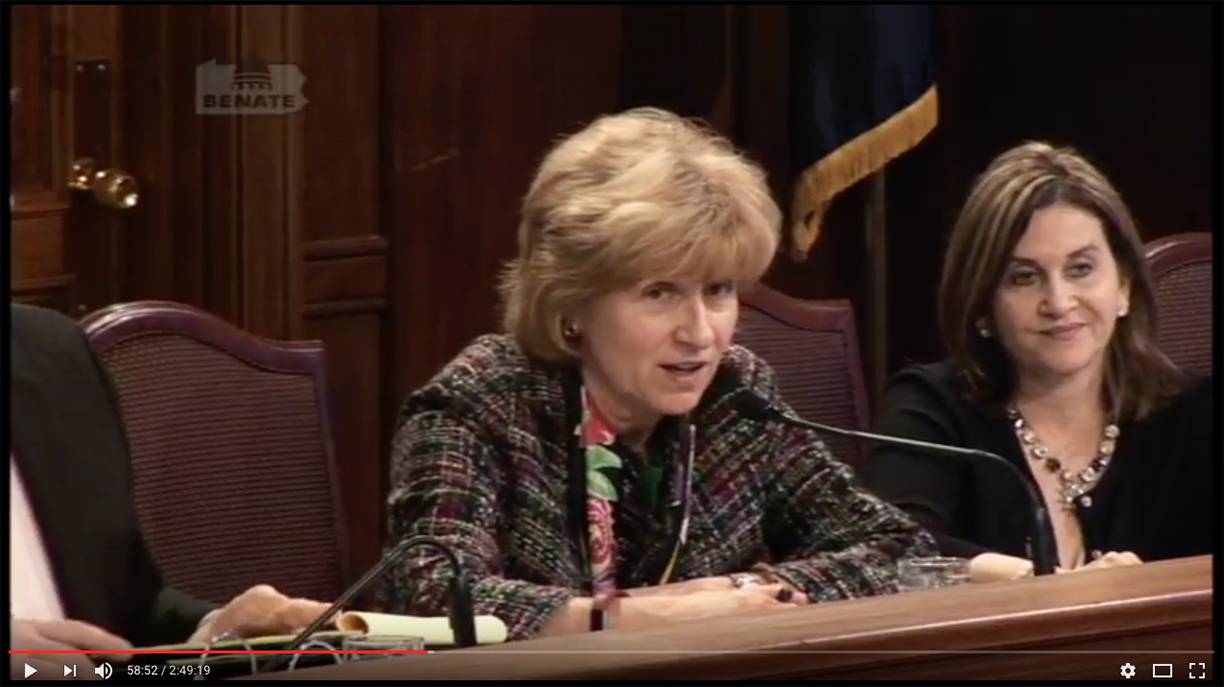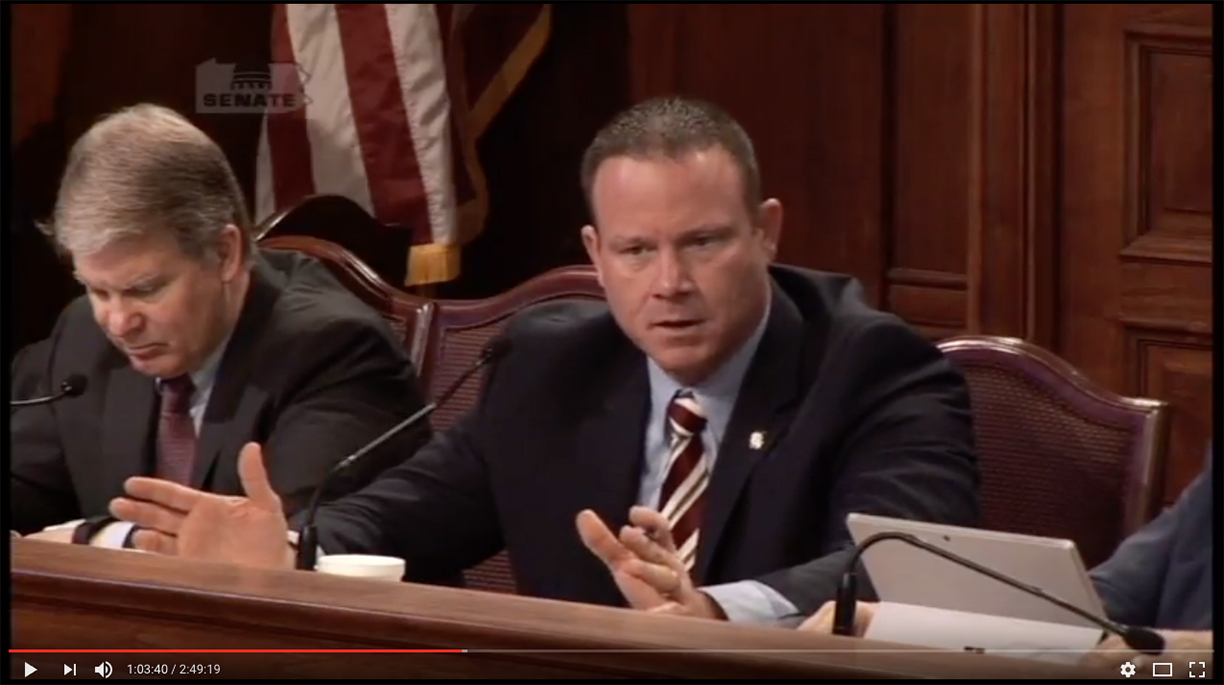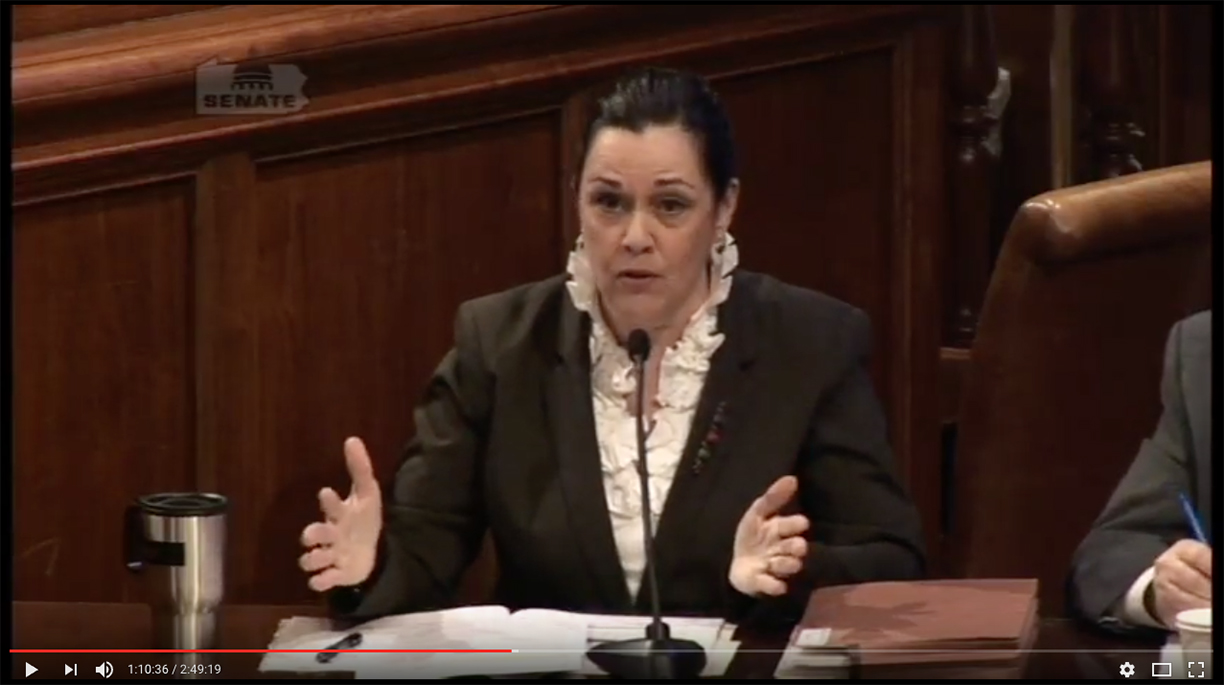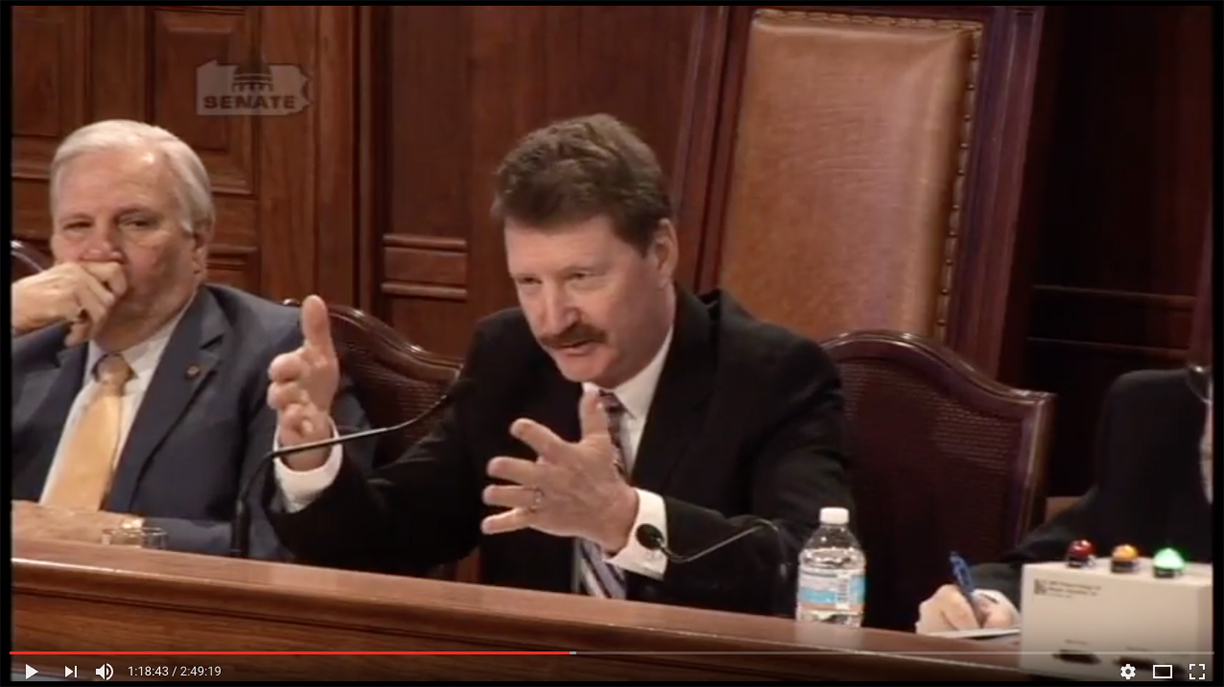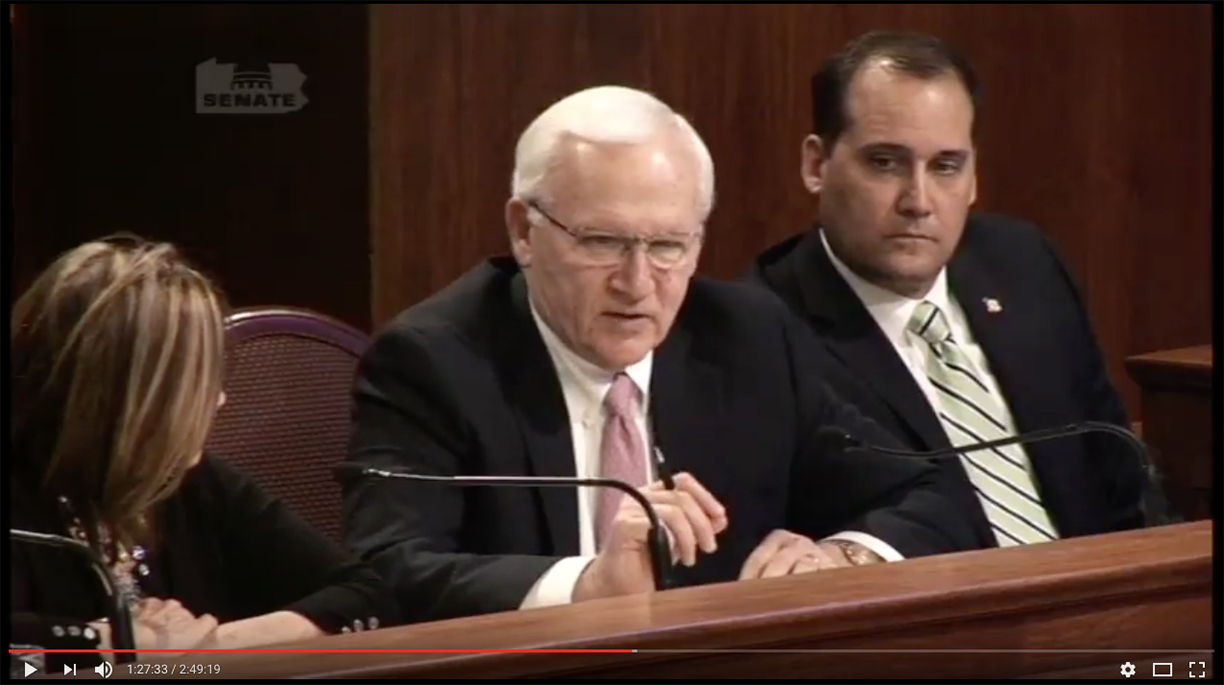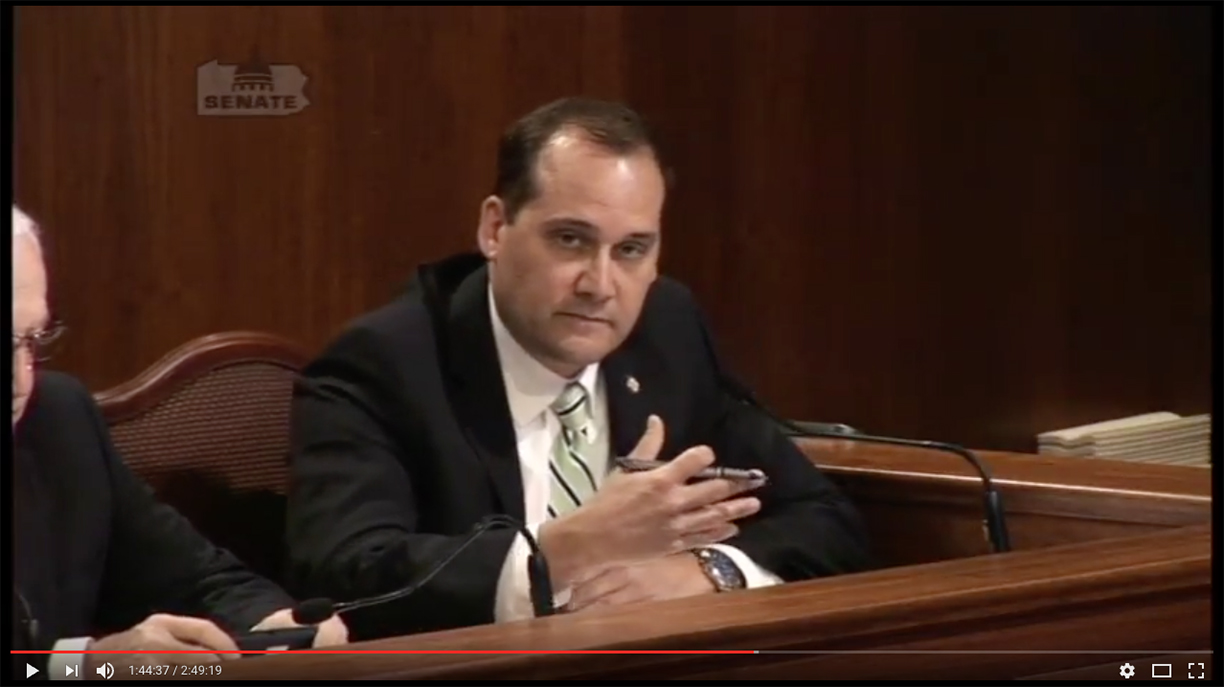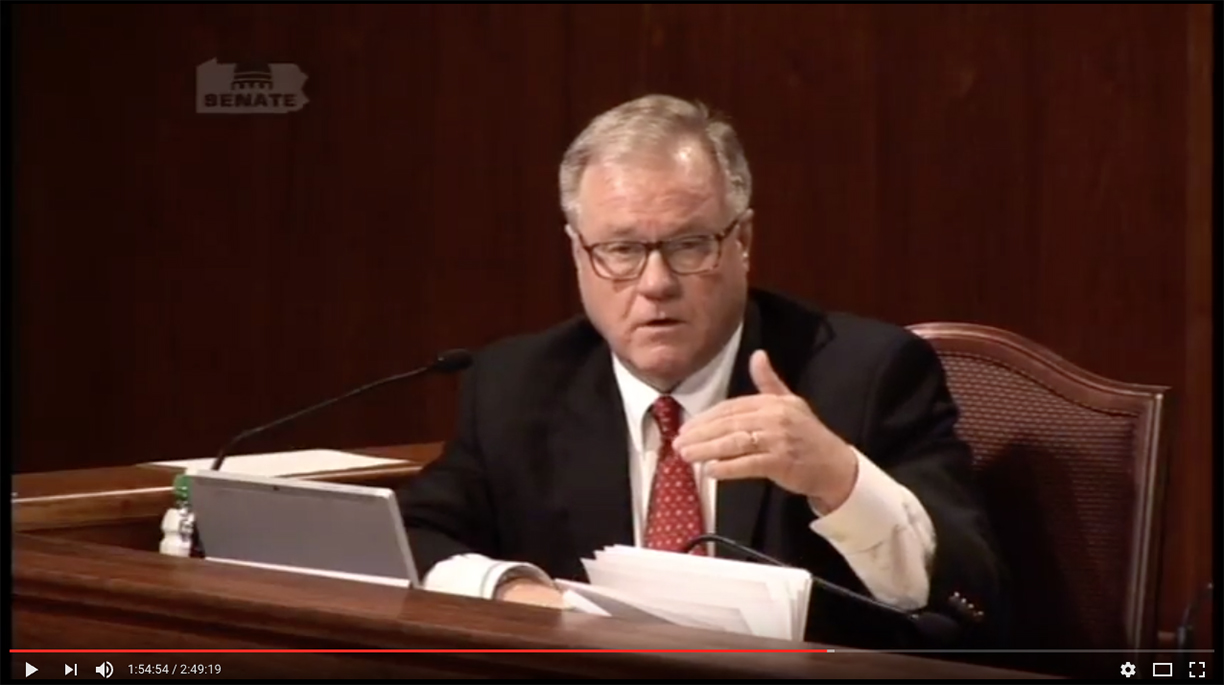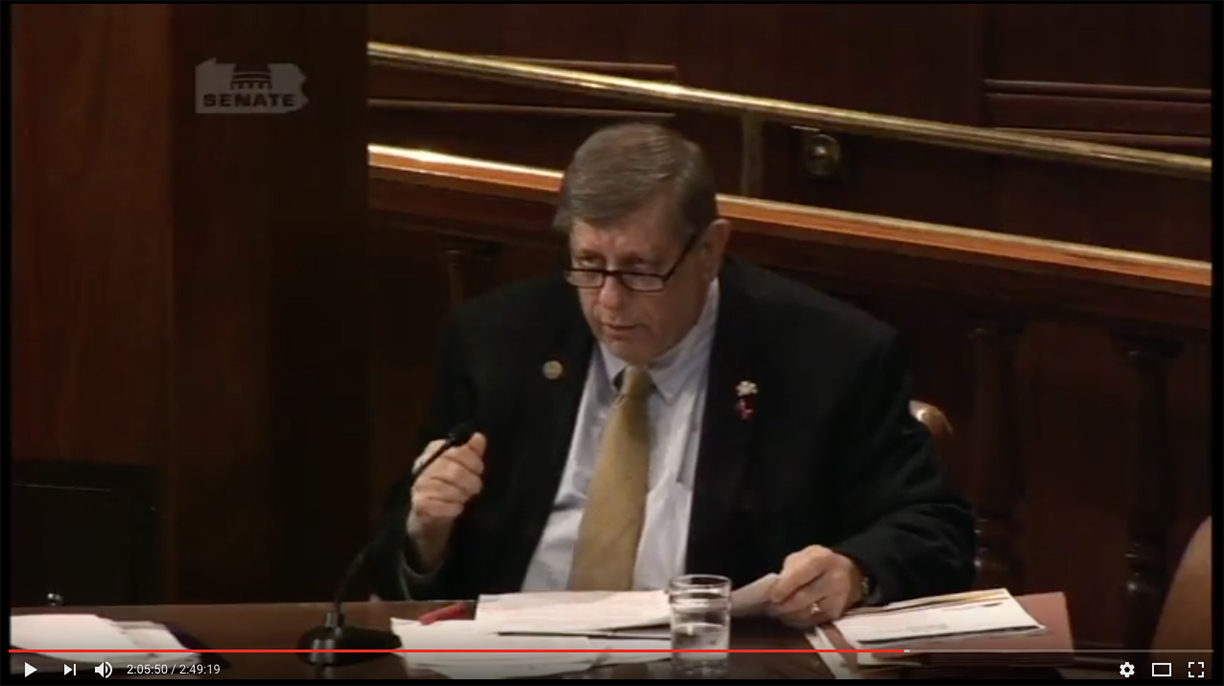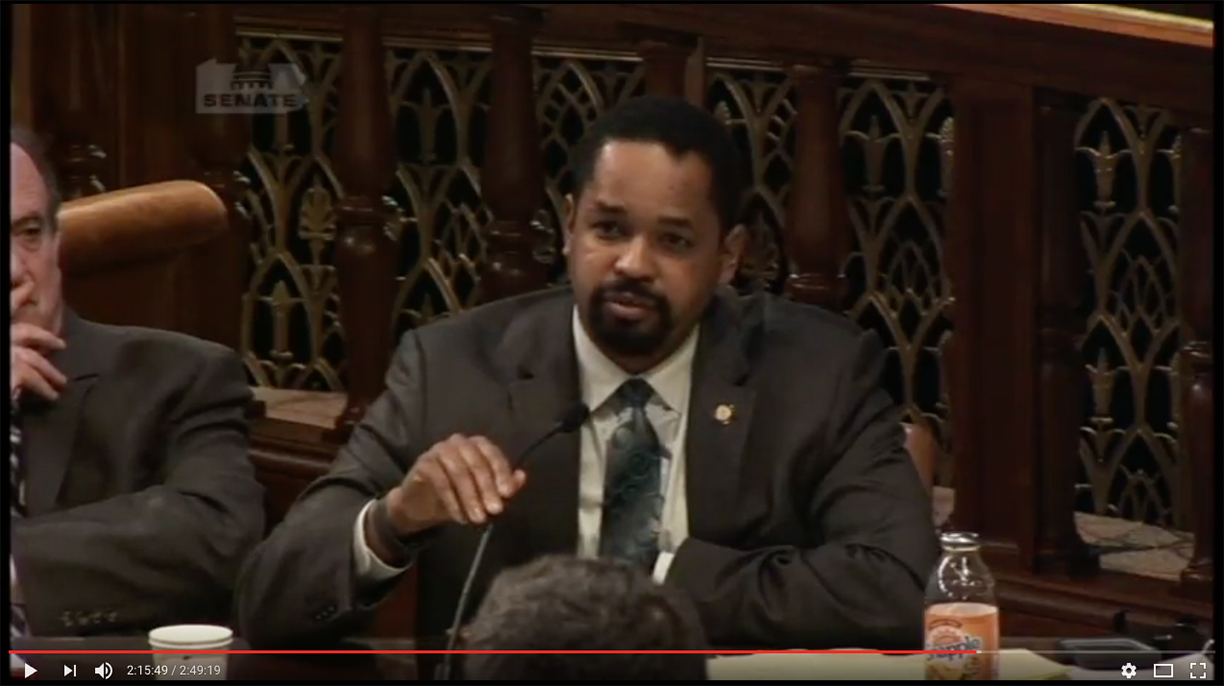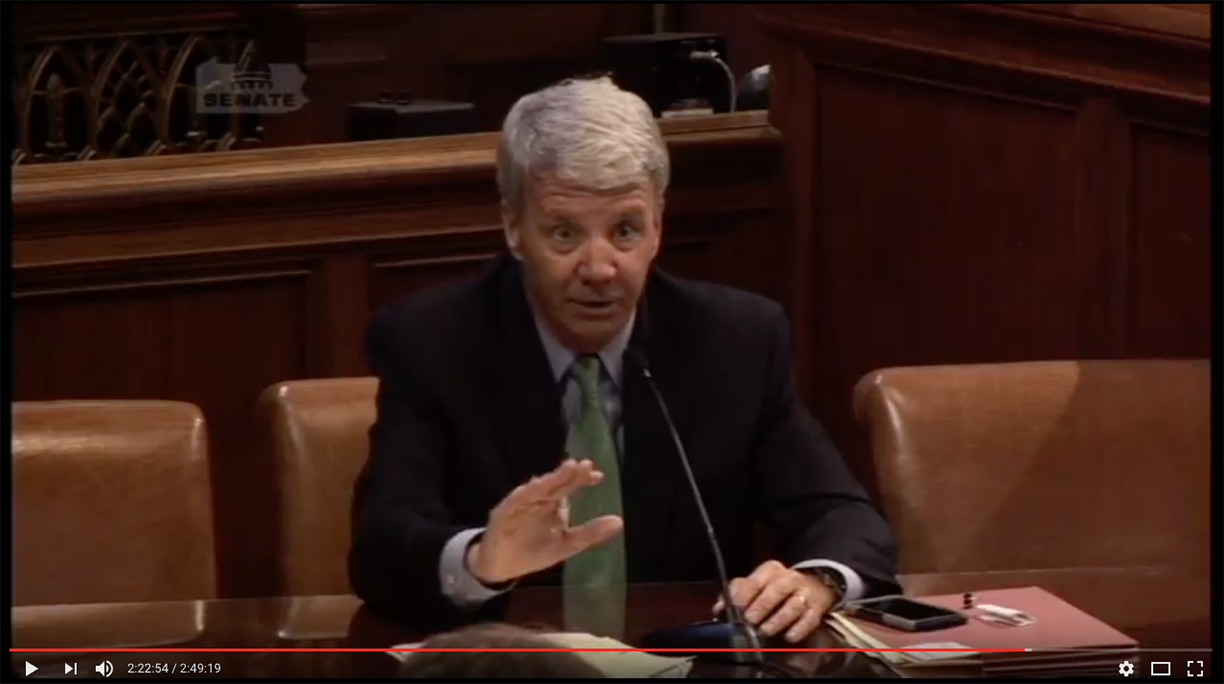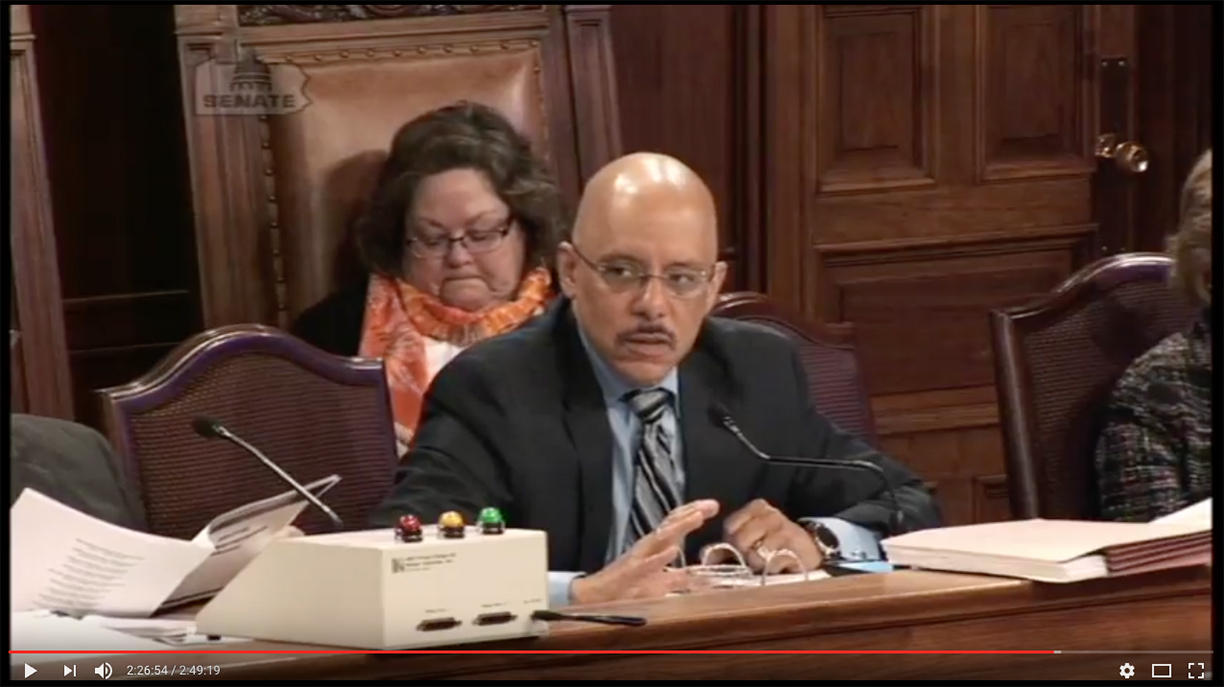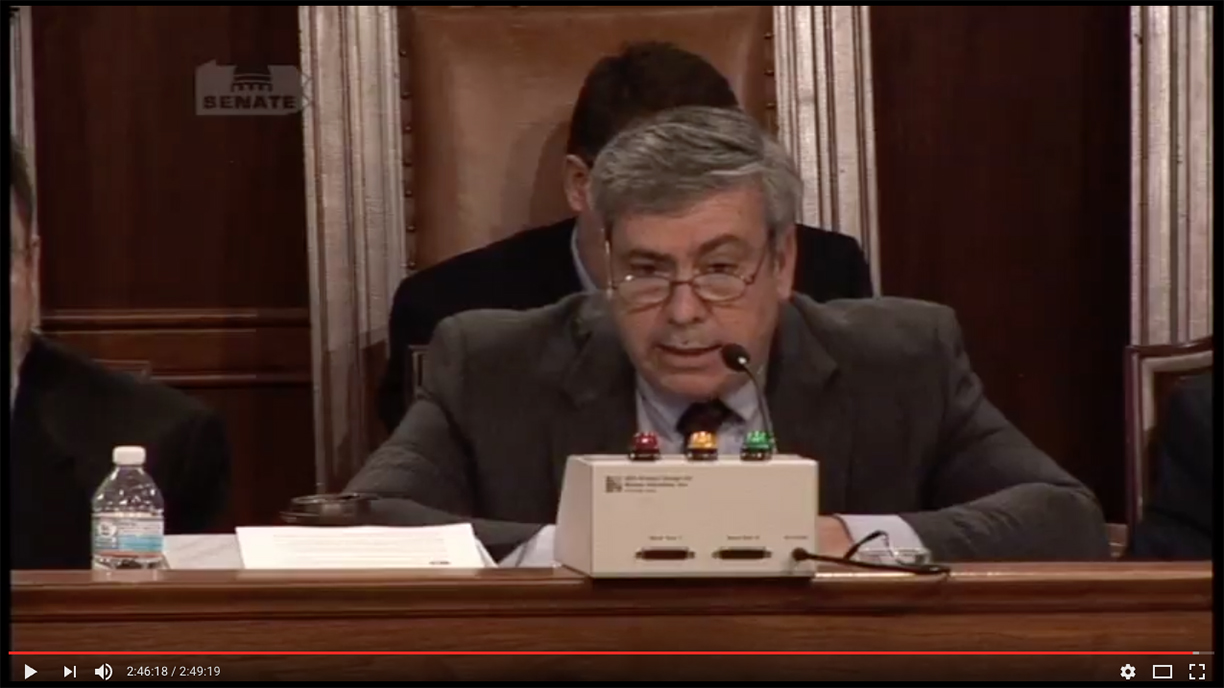APSCUF live-tweeted last month’s State System budget-appropriations hearings before the Senate and House of Representatives. If you missed those tweets, you can catch up here or watch both sessions in their entirety on our YouTube channel. Together, the hearings last about five hours, so we’ve compiled the segments we thought were of most interest to APSCUF members. First up, the Senate session, clocking in at almost three hours.
Some background: Pennsylvania’s State System of Higher Education’s Board of Governors requested a 2017–18 appropriation of $505.2 million, an increase of $61 million. In his address in February, Gov. Tom Wolf announced $8.9 million more for our 14 universities in his budget proposal.
Chancellor Frank Brogan, Bloomsburg University President David Soltz, and Logan Steigerwalt, Board of Governors nominee and Slippery Rock University student, responded to legislators’ questions. In his opening remarks, Brogan said, “Change is obviously in the wind in Pennsylvania and a necessary — very necessary — part of building a future for this state.”
Later, Brogan said, “The vibrancy of our system is directly tied to the vibrancy of the Commonwealth.” He went on to describe competition in higher education and to thank Pennsylvania for increased appropriations over the past two years.
Early in the hearings, Brogan brought up the systemwide study about which he spoke in his State of the State System address in January. The review was a major topic in last year’s appropriations hearings, when Brogan referred to it as a “reorganizational and modernizational effort.”
“This system, through its board has made a profound decision that it is now well beyond time to take a serious look at how our system of higher education is organized,” he said. “The one thing we all agree on — every president, every council member, every Board of Governors member is the following: that the system as it currently is organized is unsustainable. If the math remains similar to what it is today, we will begin somewhere along the line to see this system reorganized by itself if we don’t lift a finger first to reorganize it in the most effective way for the future.”
Brogan explained that the process has begun, with feedback expected by the summer, and he assured legislators they would be “true partners in this responsibility.” He mentioned the previous day’s Board of Governors decision to extend a line of credit to Cheyney University, contingent upon “a new institutional model that ensures it can balance its own budget in the future.” As he has said repeatedly about the systemwide study and continued to say throughout both hearings, “There’s no preconception about what will come out of the pipe” and “no sacred cows,” and that everything is on the table.
Sen. John Eichelberger, who last year commented about faculty members’ work hours, was first to ask questions. He immediately asked, “How much more is (APSCUF’s new contract) going to cost the school each year?” and then what the average salary and range are for “these professors.” Brogan provided an average and range for full professors but did not elaborate on other ranks or adjunct pay. Eichelberger then asked about requirements for faculty work weeks. Brogan explained class time, office hours, and said the so-called Snyder report (“Instructional Output and Faculty Salary Costs of the State-Related and State-Owned Universities”) averages worktime at 55 hours per week “in terms of all responsibilities being reported.”
Eichelberger asked, “When you have the drawdown of the system to prop up some schools that are having financial issues, are we losing the competitive edge at some of the schools, where then they can’t get the latest equipment, they can’t get something that they need to move ahead and excel and keep up with technology and other things because of the drawdown of funds across the board?”
Brogan answered that none of the 14 universities is rich or has a slush fund.
Sen. Andrew Dinniman said, “I represent a district in which West Chester University is there, so I can now go back and assure the faculty and the president of that university that it’s the position of the chancellor that no longer will money be taken from us, as you well know has been done in the past in the millions of dollars, to support other universities? Is that the position?”
Dinniman continued, “Is the fact that to rob Peter to pay Paul, to destroy the excellence of one university — which I think is what Senator Eichelberger was getting at — to help a university which is in difficulty or fading for whatever the reason may be is not an answer for the State System?”
Brogan said his and the board’s position was “the answer cannot lie in long-term financial prop-up of individual institutions by the rest of the system.” He said every university needs to have an advantage in being part of the system.
After questioning the timeline of the State System’s study and inquiring about enrollment issues, Dinniman declared, “On the Snyder reports, I’ve gotta put in a bill to get rid of ’em. They’re useless. … It came to a question of ‘How do we know faculty’s working?’ So you fill out this thing where you self-disclose what you do. And you can put down anything you want to put down because no one questions what you put down. I’ve seen people put down 80 hours, 75 hours, and so if we want accountability in terms of faculty work, let me say to my colleagues the Snyder report is not the answer. Snyder is long gone, and so should these reports because it was not the right approach to accountability.”
Dinniman asked about metrics to be used in the systemwide study. Brogan said they would include enrollment and enrollment trends, issues of cost per student, the “academic array,” supply-demand gap analysis, and diversity of student population.
“We have to also look at a forecast for the future to try to determine what can be sustainable at an institution over the long haul to assure that it’s organized in a way where it can pay its bills with the money it generates, whatever that happens to be,” Brogan said.
Sen. David Argall asked about the study’s cost, collaboration and whether anything was off the table. Brogan reiterated, “Everything has to be on the table. If sacred cows are created along the way, they’ll stack up in the pasture to the point where nothing will happen.”
Sen. Judith Schwank, after asking about cash flow, said, “We’ve got to have the fortitude, then, to make the changes that this study will recommend.”
Sen. Scott Martin asked about online degree programs’ effect on online enrollment. Brogan replied that distance education has an impact on new programming.
“The whole idea of technology and its usefulness in the area of education generally speaking is to be able to tamp down redundancy and create greater efficiency, and that efficiency can be passed along to students by less cost,” Brogan said. He discussed pooling resources and the “genius of faculty.”
Martin said he hoped the study would “take a look at the amenities war that’s going on.” He then asked about how families can determine how investment in higher education will pay off. Brogan referred to the State System’s gap-analysis study.
Sen. Lisa Baker asked if the System’s study will include the infrastructure of the State System’s office as a whole, including operational costs and construction. Brogan repeated, “We have to look at everything,” including the Office of the Chancellor.
Steigerwalt said students value the small faculty/student ratio at his campus. Baker asked him about student concerns, and he replied that students are concerned about the value of their degrees. Experiences set the State System apart, he elaborated.
Sen. Elder Vogel Jr. asked about universities’ advertising criteria and budgets, which Brogan explained is up to individual universities.
Sen. Gene Yaw said he’s not sure if the system’s “geographics work anymore” and asked about the guidelines for the study’s request for proposals — whether closure, consolidation, or specialization are options. Brogan replied that the study needs to “recognize that what we’re doing … in the majority of cases isn’t working the way it did 10, 15, 20, or even 30 years ago, and therefore there is an obligation to change.”
“We can change the business model in our System all day long and maybe even create a greater sustainability just in the ledger accounting of this thing for a longer period of time,” Brogan said. “But the heart and soul of what we do on these campuses occurs in classrooms and laboratories, and if we just continue to accept the way we are — and in many cases have been for a long time — and that isn’t considered in this change process at the same time, we will be only creating half a loaf.”
Yaw said he was concerned about the State System’s four-year graduation rate of less than 50 percent. Brogan pointed to the national average of about 27 percent. The State System’s six-year graduation rate also is above the national average.
“But, be that as it may, that can’t be our high-water mark,” Brogan said.
He continued: “We’ve always got to make sure that we’re trying to organize in a way that will continuously drive up not only the number of graduates but the time in which students graduate. Simple mathematics. The faster you graduate, the less you’re gonna pay.”
Sen. Wayne Langerholc Jr. asked what the State System is doing to educate students about rising costs and debt.
“The only way to close that gap, I believe, is to continue to better educate families as to the actual cost to bear so that they can make better-informed decisions about the total cost, No. 1,” Brogan said. “ … Also to help students acquire jobs.”
Sen. Scott Wagner asked about the breakdown of the State System’s request for $61 million, saying he was very interested in “the faculty side.”
“It’s no secret that your faculty went on strike this year,” Wagner said. “Because people are listening, would you just give us a little background of when that occurred and how many days they were out?”
Brogan replied that the three-day strike was over issues of salary, benefits, and contract language. He mentioned changes to the healthcare plan.
“We got through collective bargaining generally speaking, but both the issue of the healthcare plan was still a hanging issue but also hanging were a variety of contractual issues that we felt needed to be changed for the future of this system,” Brogan said. “But also some of those would have created greater efficiency and provided money back to the system because of the change that was met — not in every case, but there were those that fell into that category. We broke down at the end of about a year-and-a-half process, and the strike was called.”
Wagner followed with, “So, during whole this year-and-a-half of negotiations, at any time were people not paid?”
“Uh, no sir,” Brogan replied. (We’ll get to compensation during the strike in a few minutes.)
“So, paychecks continued to roll,” Wagner said. “So I find that fascinating.”
He requested every university supply a list “in ranking order of the faculty and what their salaries are … Because I know … the famous West Chester swim coach has a base of $80,000 but he gets another over $200,000 for selling snowballs and other projects he’s working on.”
He continued to ask questions about the well-documented APSCUF strike.
“Did your agency facilitate the strike?” Wagner asked. “Did you basically say that the teachers … who? … I’m just curious. I think people need to know how this whole thing works. Who directed the teachers or the faculty to go on strike?”
Brogan explained that the State System does not call a strike — that it is a decision made by the bargaining unit — and he outlined the strike-authorization process.
Wagner asked what union (or unions) represents the faculty. Brogan answered that APSCUF represents faculty and coaches.
“So actually, that seems like a pretty powerful union on this System,” Wagner said.
Editor’s note: You are correct, Sen. Wagner.
“The process that exists that I have found since coming to Pennsylvania is a very powerful process,” Brogan replied.
“But at no time now, even when the teachers went on strike, were they compensated for the time they were off?” Wagner asked.
“No,” Brogan answered. “According to the rules of engagement, you are not compensated unless other arrangements are made later. You are not compensated for the time that you are off in a strike.”
“Actually, you just used a very interesting term: ‘rules of engagement,’” Wagner said. “That’s a war term that’s used over in the Middle East when we are engaging in war with an enemy. So, wow. That’s pretty interesting. ‘Rules of engagement’ with the university system and the teachers. I find that fascinating.”
Wagner returned to the West Chester University swim coach, referring to an article on PennLive that listed the coach as making more than $300,000. Wagner did not mention that Brogan is third on the list, with earnings of $344,245.
“How did that happen?” Wagner pressed. “I mean, you’re telling us the average salary is $85,000. I mean, I’m curious. Are there people out there listening that could apply for that job?”
Brogan explained that the coach runs camps and earns a percentage of the proceeds.
“The university gleans a substantial amount of money from that operation, and they are apparently wildly popular,” Brogan said.
Wagner asked whether the coach’s pension would be based on his base salary or total compensation. Brogan answered that it would depend on his pension plan, with which Brogan was not familiar.
“So his pension would be based on $300,000, so it would be safe to say that he would retire with $200,000 a year, which would at least be two-thirds of the $300,” Wagner said. “Wow. Do you have a hotline that people could call? This is like the deal of the century. So I just think people need to know. I mean, we have a pension crisis right now in the state of Pennsylvania, and I mean this is just, it’s just wild to me how this system works.”
Sen. Randy Vulakovich asked how it was possible to improve Cheyney University’s 7.9 percent four-year graduation rate and 17.5-percent six-year graduation rate. He also asked why it had not been addressed earlier. He said legislators need to know what questions will be in the RFP and that hard questions must be asked. Brogan explained that the RFP was not a finalized plan; the study could evolve once the system starts hearing from faculty, students and others.
“What do you do with a school campus if you close it?” Vulakovich asked. He used Clarion as an example. “What do you do with these campuses? Do you try to get rid of the whole campus? Or do you try to parcel it out? There needs to be a plan set for this because as long as there’s not a plan, and we know certain things we have to do, and I don’t know. I mean, maybe the decision, like I said it’s 7.9 percent and 17.5 percent and getting money from the others. The decision on Cheyney is probably already premade without the stamp until the study comes in, but there needs to be some decision about what’s gonna happen to that, and can it be put to some other value for some other educational purpose for the people that could use it there?”
Brogan replied that campuses are Commonwealth assets, so the State System cannot sell off or lease property.
“That’s the approach we’re taking as a system,” Brogan said. “Not to say, ‘We’ll just shut it down,’ Cheyney a good example. Let’s find a different approach that’s more sustainable that’s also gonna have other residual impacts as it relates to getting it there.”
Sen. Sharif Street stood up for Cheyney University
“Metrics and data are great to evaluate decisions,” he said. “But as all of us know, metrics and data, depending on which metrics you look at and which data, they can drive the nature of your decision. When a business decides where it’s gonna make its investment, it tends to focus on where there is the greatest market. In educational institutions, one of the factors that you mentioned earlier is that they tend to draw regionally from their population. When you look at Cheyney University, you have to look at, ‘Is there a population to draw from?’ Well, Delaware County is one of the fastest-growing counties in the nation. Montgomery County is also a growth county. Philadelphia County is a growth county. Chester County is a growth county, with respect to population and job growth. And so it would seem to me that there is an administrative failing if in an area that has a growth, a population growth, when neighboring institutions are able to grow at some of the fastest rates, when Cheyney University has not been able to grow. There are a growing number of jobs in the southeast, unlike some regions of the state, where those students are coming from, and so there should be a way to place them there. And to the extent that the PASSHE system hasn’t found a way to take an institution which is positioned in a place where there is growth in terms of the population pool it’s growing from, there’s the need for the educational services that are provided. … So the metrics would suggest, ‘Is there a need for Cheyney?’ I think the metrics would suggest that there is a need for Cheyney, but the metrics would suggest a failure on the part of the PASSHE system to appropriately utilize a resource that we have at our disposal to appropriately give us the return on that investment. … Educating people is a net gain to the Commonwealth, unlike incarcerating people, which is a net loss. It’s just an expense. When those people leave, they are less likely to be productive citizens in society. When we educate them, they are more likely to be productive citizens in society. So we had great outcry about closing institutions which employed people in rural areas because of the need for rural population, but now we have an institution, and several institutions, which are located in rural populations, where those people would be hard-pressed to find additional jobs if we didn’t, and the product that they’re selling and the market that they’re selling in is a growth market and a product that’s needed, but yet we have not found a way to make that work. I’m being candid. The people I represent believe that Cheyney should continue to exist. The metrics that I would evaluate this would suggest that there is a market for this institution and many of these institutions to continue to exist.”
Brogan replied, “As it relates to Cheyney, it would take us more time than you have in a public meeting to talk about the number of individuals, groups and constituencies who have led Cheyney to where it is today. That is not to pass the buck because it includes PASSHE. … Do we want to figure out, as was stated yesterday, ‘Where are we going to go with Cheyney in the future?’ It wasn’t a question of closing it. It was a question of ‘How do we quickly pivot Cheyney to a sustainable institution of higher education that still makes teaching and learning the paramount import for its students, now and into the future. That’s where we’ve gotta go.”
Sen. Thomas H. Killion said he is looking forward to making Cheyney, with its beautiful campus and prime location, sustainable. He asked about investment in Cheyney’s Keystone Honors Academy, and Brogan discussed its continued success. He called it “as sound an investment in the future of Cheyney that this body and the general assembly … can make. … You could argue a lot of things about success or lack of success at Cheyney. You can’t argue about the continued success of the Keystone Honors Program.”
Sen. Vince Hughes echoed the praise of Cheyney’s honors program, calling it the best-rated honors program of any historically black college or university in the nation.
He went on to describe the purpose of the State System.
“The system was created to be mutually supportive of one another,” Hughes said. “The system was created to allow these 14 institutions all across Pennsylvania who more than likely would fall on their face if not for a system … for collective work together. And this goes from West Chester to Lock Haven to Shippensburg to Indiana University of Pennsylvania to all of these entities. That’s why the system was created. They were in a problem where they were almost 30 years ago, and a system was created to mutually support them, to lift them up because they were champions for education and academic success and mobility for their communities. … So when you hear conversations of universities or the system supporting universities, this one this year, this one that year, this one another year, it is consistent with the original mission. Now I’m not making it up. It’s in the archives. It’s in the history. It’s in the original legislation. … It’s important to point out so that when institutions struggle, there is a system to lift it up. … It is designed to help those who are in distress, or maybe, better said, it is designed to complement other institutions. And make sure that we minimize duplication and that we support one another. It’s had its fits and starts. It’s had its great successes. It has its problems. It is organic, like we all are, and we all go through ups and downs. But be clear that this issue of supporting one another is what the system was designed to do. Because all these institutions were, before the system was created, were in some level of distress. OK? And then the system was created because somebody felt, and I agree, that it was the responsible thing to do to figure out a way to lift them all up because they are the only thing in Mansfield. They are the only thing in many respects in Lock Haven. In Bloomsburg, Pennsylvania, that’s what you’ve got. You’ve got the university, and it’s a driving academic and financial force within that community. And it is a place where folks in that neighborhood can go and transform their lives.”
He highlighted the correlation between enrollment decreases and decreased appropriations.
“What is very clear to me is that university enrollment has declined across the board, directly tied to investments from the Commonwealth of Pennsylvania. … You look at the numbers for the state appropriation for ’09 and ’10, $530 million, and in fall of 2010, the system enrollment was 119,000 students. All right? … Appropriations dropped in ’14–’15 to $412 million … and the enrollment dropped from 119,000 to 109,000. … And there was a four-year consistent appropriation, from 2011 to 2015 of $412 million. Every year we stayed static. Now, we were at $530, Mr. Chairman. We dropped to $412 and just have begun making progress back. … We cannot separate out that issue, especially if we say that we are committed to low-income, high-quality options that the 14 State System universities provide. … When we stop investing the money, the students don’t come. When we invest the money, the students attend. So if we want to look at metrics, if we want to look at linear analysis and all of that stuff that accountants and guys look at, we cannot divorce ourselves from something that’s very basic. … We need not to ignore the original mission (during the study) … If we don’t invest in it, then it won’t be that opportunity for our children.”
Hughes then distributed copies of a New York Times article about upward mobility in which Cheyney University ranks highest among the 14 State System universities.
“(The State System) was put together for everybody, not just for a few,” Hughes concluded.
Sen. Patrick Browne, chair of the appropriations committee, wrapped the hearing.
“There’s a group that doesn’t have access yet or has chosen access yet, and as Senator Hughes says, your product is the product that a lot look to, at least in terms of an affordability standpoint, and a program standpoint as well, for access,” Browne said. “So I think those opportunities are available to us and probably would be considered during your studies. Senator Hughes is also correct regarding our level of appropriation. If we approve the governor’s number, we’re appropriating about the same amount we appropriated in 1999. And that really brings into question, ‘Where are we going?’ in regards to supporting higher education as a component of our overall budget. We often talk about economic development in relation to taxes and regulations and healthcare costs, but what we hear mostly from employers now … is the No. 1 thing that’s gonna drive employment in the next 20 years, especially in high-end employment, is gonna be workforce competence — the strength of the workforce, and their skills to provide that employer with what’s necessary to bring their product and service to market. So if we have an overall strategy for our budgeting, and our appropriations are going up in corrections and human services and down in higher education … our overall strategy is going in reverse to what the economic needs need to be in Pennsylvania and our ability to attract and keep that working-age workforce that will allow for our financial picture to improve. We can go through a process year over year of looking for savings and reductions … but the thing that will be the most sustainable over time is a growing economy, and if workforce competence is the No. 1 thing that will drive that, then our budgets … should reflect that.”
* * *
With the hearings complete, our work in advocating for fair funding of our universities has just begun. APSCUF is working to make Gov. Tom Wolf’s proposed $8.9 million appropriations increase — or more — stick in the 2017–18 budget.
APSCUF launched a series of graphics on social media, detailing how our 14 state-owned universities serve all Commonwealth residents and why an investment in our State System is an investment in the entire state. Please retweet and share the graphics on your social media accounts. Use the hashtag #fundPAfuture when posting about the Pennsylvania budget and the future of our universities.

